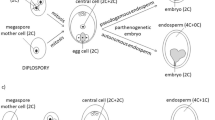Abstract
Porella platyphylla andP. cordaeana are genetically well differentiated in Europe (I = 0.486). Isozyme data from 156 European colonies reveal thatP. baueri is polyploid and could be an interspecific hybrid between these two species. It is characterized by large lobe cells, toothed margins of the female bracts, and ciliate perianth mouth. Correspondence analysis using morphological characters revealed that its colonies cluster into two geographicallý separated groups, similar to one or other of the putative parental species. These results agree with the genetic analysis, that also revealed two main allelic associations, each with a distinct geographical range. We hypothesize that this pattern was produced by introgression subsequent to hybridization, or by gene silencing. The discovery of this new, allopolyploid species suggests that hybridization is an important evolutionary process in liverworts.
Similar content being viewed by others
References
Arnold, M. L., 1992: Natural hybridization as an evolutionary process. — Annual Rev. Ecol. Syst.23: 237–261.
Boisselier-Dubayle, M. C., Bischler, H., 1994: A combination of molecular and morphological characters for delimitation of taxa in EuropeanPorella. — J. Bryol.18: 1–11.
—, 1995a: Genetic variability in western EuropeanLunularia. — Fragm. Florist. Geobot.40: 379–391.
—, 1995b: Genetic variability in three subspecies ofMarchantia polymorpha: isozymes, RFLP and RAPD markers. — Taxon44: 363–376.
—, 1996: Progeny analysis by isozyme markers in the polyploid liverwortPlagiochasma rupestre. — Canad. J. Bot.74: 521–527.
Crum, H., 1972: The geographic origin of the mosses of North America's eastern deciduous forest. — J. Hattori Bot. Lab.35: 269–298.
Doddema, H., Walsma, J., van Zanten, B. O., 1971: An analysis ofPorella platyphylla (L.)Lindb. andPorella baueri (Schiffn.)Evans from Europe. — Lindbergia1: 60–65.
Fritsch, R., 1974: Chromosomenzahlen einiger Lebermoose aus der Hohen Tatra. — Lindbergia2: 234–236.
—, 1984: Zytologische Untersuchungen an Bryophyten aus dem Harz. — Herzogia6: 345–356.
- 1991: Index to bryophyte chromosome counts. — Bryophytorum Bibliotheca40.
Greuter, W., 1994: (Ed.): International code of botanical nomenclature (Tokyo Code). — Königstein: Koeltz.
Jonsson, B. G., Söderström, L., 1988: Growth and reproduction in the leafy hepaticPtilidium pulcherrimum (G. Web.)Vainio during a 4-year period. — J. Bryol.15: 315–325.
Lumaret, R., Barrientos, E., 1990: Phylogenetic relationships and gene flow between sympatric diploid and tetraploid plants ofDactylis glomerata (Gramineae). — Pl. Syst. Evol.169: 81–96.
Müller, K., 1905: Ueber die in Baden im Jahre 1904 gesammelten Lebermoose. — Beih. Bot. Centralb.18: 323–346.
—, 1951–1956: Die Lebermoose Europas. — InRabenhorst, L., (Ed.): Kryptogamenflora, 3rd edn.6. — Leipzig: Geest & Portig.
Nei, M., 1972: Genetic distance between populations. — Amer. Naturalist106: 283–292.
—, 1973: Analysis of gene diversity in subdivided populations. — Proc. Natl. Acad. Sci. USA70: 3321–3323.
Newton, M. E., 1975: Chromosome studies in some British bryophytes. — J. Bryol.8: 365–382.
—, 1986: Bryophyte phylogeny in terms of chromosome cytology. — J. Bryol.14: 43–57.
—, 1990: Genetic structure of hepatic species. — Bot. J. Linn. Soc.104: 215–229.
Odrzykoski, I. J., Chudszinska, E., Szweykowski, J., 1996: The hybrid origin of the polyploid liverwortPellia borealis. — Genetica98: 75–86.
Rieseberg, L. H., Ellstrand, N. C., 1993: What can molecular and morphological markers tell us about plant hybridization? — C. R. C. Crit. Rev. Pl. Sci.12: 213–241.
Roose, M. L., Gottlieb, L. D., 1976: Genetic and biochemical consequences of polyploidy inTragopogon. — Evolution30: 818–830.
Schiffner, V., 1900: Nachweis einiger für die böhmische Flora neuer Bryophyten nebst Bemerkungen über einzelne bereits daselbst nachgewiesenen Formen. — Lotos48 (N. F. 20): 320–354.
—, 1936: Kritische Bemerkungen über die europäischen Lebermoose. Serie XX. — Horn: Berger.
Schuster, R. M., 1966: TheHepaticae andAnthocerotae of North America.1. — New York: Columbia University Press.
—, 1980: TheHepaticae andAnthocerotae of North America.4. — New York: Columbia University Press.
Shaw, A. J., 1991: Ecological genetics, evolutionary constraints and the systematics of bryophytes. — Adv. Bryol.4: 29–74.
—, 1994: Systematics ofMielichhoferia (Bryaceae:Musci). III. Hybridization betweenM. elongata andM. mielichhoferiana. — Amer. J. Bot.81: 782–790.
Smith, A. J. E., 1978: Cytogenetics, biosystematics and evolution in theBryophyta. — InWoodhouse, H., (Ed.): Advances in botanical research,6, pp. 196–277. — London: Academic Press.
Soltis, D. E., Soltis, P. S., 1993: Molecular data and the dynamic nature of polyploidy. — C. R. C. Crit. Rev. Pl. Sci.12: 243–273.
Stoneburner, A., Wyatt, R., Odrzykoski, I. J., 1991: Applications of enzyme electrophoresis to bryophyte systematics and population biology. — Adv. Bryol.4: 1–27.
Swofford, D. L., Selander, R. B., 1981: BIOSYS-1: a Fortran program for the comprehensive analysis of electrophoretic data in population genetics and systematics. — J. Heredity72: 281–283.
Therrien, J. P., Stotler, R. E., Crandall-Stotler, B., 1996: ThePorella platyphylla andP. platyphylloidea species complex — an analysis of genetic and morphological variation. — Amer. J. Bot. (Abstracts)83 (6): 21.
Werth, C. R., Guttman, S. I., Esbaugh, W. H., 1985: Recurring origins of allopolyploid species inAsplenium. — Science228: 731–733.
—, 1991: A model for divergent, allopatric speciation of polyploid pteridophytes resulting from silencing of duplicate gene expression. — Amer. Naturalist137: 515–526.
Wyatt, R., 1985: Species concepts in bryophytes: input from population biology. — Bryologist88: 182–189.
, Odrzykoski, I. J., Stoneburner, A., Bass, H. W., Galau, G. A., 1988: Allopolyploidy in bryophytes: multiple origins ofPlagiomnium medium. — Proc. Natl. Acad. Sci. USA85: 5601–5604.
,, Stoneburner, A., 1992: Isozyme evidence of reticulate evolution in mosses:Plagiomnium medium is an allopolyploid ofP. ellipticum ×P. insigne. — Syst. Bot.17: 532–550.
,, , 1993a: Isozyme evidence regarding the orgins of the allopolyploid mossPlagiomnium curvatulum. — Lindbergia18: 49–58.
,, , 1993b: Isozyme evidence proves that the mossRhizomnium pseudopunctatum is an allopolyploid ofR. gracile ×R. magnifolium. — Mem. Torrey Bot. Club25: 21–35.
Author information
Authors and Affiliations
Rights and permissions
About this article
Cite this article
Boisselier-Dubayle, M.C., Lambourdiere, J. & Bischler, H. The leafy liverwortPorella baueri (Porellaceae) is an allopolyploid. Pl Syst Evol 210, 175–197 (1998). https://doi.org/10.1007/BF00985667
Received:
Revised:
Accepted:
Issue Date:
DOI: https://doi.org/10.1007/BF00985667




